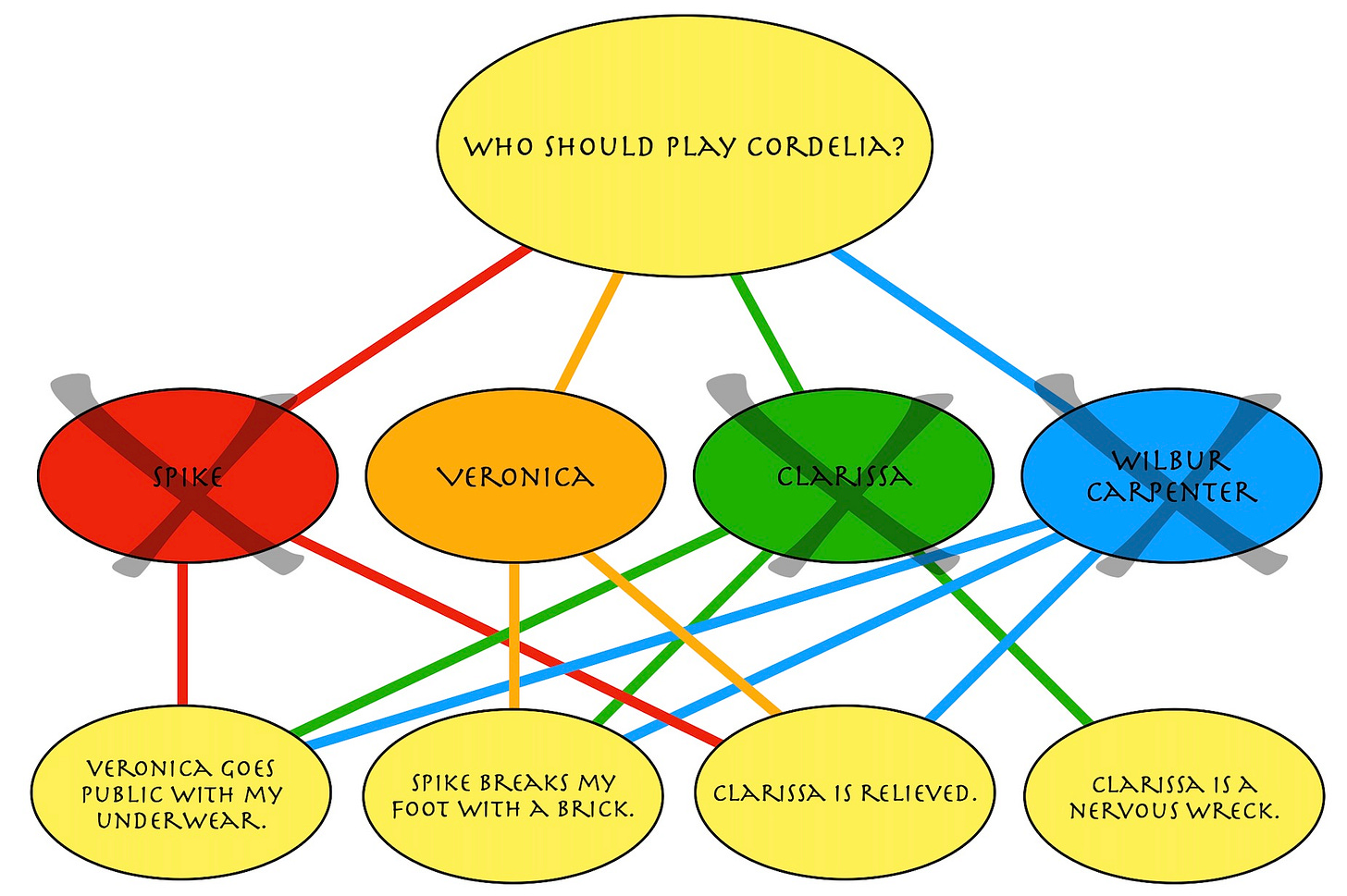Decisions: The Decision Process
I WOKE EARLY on Sunday morning and sat upright in my bed thinking the situation over. My two biggest problems were Spike and Veronica. Until I chose one of them to play the part of Cordelia, I wasn’t going to be able to think about the other roles. Thank goodness I didn’t have to worry about Clarissa, too. … I decided to give the part to Veronica.
Little Follies, “The Girl with the White Fur Muff”
The Art of Decision-Making
When making a decision, we form opinions and choose actions via mental processes which are influenced by biases, reason, emotions, and memories. The simple act of deciding supports the notion that we have free will. We weigh the benefits and costs of our choice, and then we cope with the consequences. Factors that limit the ability to make good decisions include missing or incomplete information, urgent deadlines, and limited physical or emotional resources.
A decision tree is a decision support tool that uses a tree-like model of decisions and their possible consequences, including chance event outcomes, resource costs, and utility. It is one way to display an algorithm that only contains conditional control statements. …
Roles and Casting (in Theater and Life): Traditional and Nontraditional
Mrs. Graham’s notes weren’t very helpful, since she had recommended giving the part [of Cordelia] to Wilbur Carpenter.
Little Follies, “The Girl in the White Fur Muff”
Mrs. Graham may have been a traditionalist adhering to the casting conventions of Shakespeare’s time or an advocate of nontraditional casting avant la lettre.
During the time of Shakespeare and the reigns of Queen Elizabeth I and King James I, English ideas of sex and gender, the legal rights of women and the social expectations of femininity all played a significant role in the way that theatre was performed, the stories it told and who told them. In addition to other legal restrictions on the rights of women, there was considerable social pressure on women to behave according to specific social roles. Women were expected to be subservient, quiet and homebound, with their primary ambitions entirely confined to marriage, childbirth and homemaking; granted, social status and economic class played into what degree these expectations manifested, with the chief example being Queen Elizabeth I herself.
Acting was, in some ways, the exact opposite of those expectations, and female actors were associated with sexual incontinence, prostitution, lasciviousness and indecency. Though there is evidence that women acted in street performances, and in other notorious venues, all commercial acting companies of the time were made up entirely of men and it was illegal for women to act on stage professionally until 1661. Despite the profession of acting having a less than virtuous reputation, as well as a growing orthodox Christian objection to the theatre, these all-male companies were deemed as socially legitimate because they did not threaten gender hierarchy. Only the idea of women was portrayed and embodied on stage, and not the reality. These professional companies were often financed by royal patronage, for example, The King’s Players.
Lucas Garcia, “Gender on Shakespeare’s Stage: A Brief History,” Writers Theatre, November 21, 2018
Nontraditional casting means the use of actors of any race, sex, ethnic background or degree of disability in roles for which such factors are not germane to the development of stage characters or the play.
Joe Brown, “Nontraditional Casting Not Just a Character Issue,” The Washington Post, November 23, 1987
[more to come on Tuesday, December 14, 2021]
Have you missed an episode or two or several?
You can begin reading at the beginning or you can catch up by visiting the archive or consulting the index to the Topical Guide.
You can listen to the episodes on the Personal History podcast. Begin at the beginning or scroll through the episodes to find what you’ve missed.
At Apple Books you can download free eBooks of “My Mother Takes a Tumble,” “Do Clams Bite?,” “Life on the Bolotomy,” “The Static of the Spheres,” and “The Fox and the Clam,” the first five novellas in Little Follies.
You’ll find an overview of the entire work in An Introduction to The Personal History, Adventures, Experiences & Observations of Peter Leroy. It’s a pdf document.



